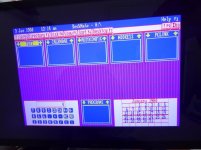I made sure this is a PC CGA converter and not one of the Arcade GBS-8200 Video Converter which will require an additional board to work with CGA.
This video confirms that it should work as a PC CGA to VGA converter
The video is about using it for MDA, which should work fine... except actually it doesn't, I'll get back to that. The issue is that this device only has three inputs in digital mode, "R", "G", and "B". CGA has four digital outputs, AKA, it's called "RGBI", and those four signals are the aforementioned RedGreenBlue PLUS an "Intensity" signal. This gives 4 bits total of color information for each pixel. 2^4 = 16. This converter doesn't know anything about the "I" signal so you're only going to get 2^3, or 8 colors. This isn't going to matter that much (probably) if you're buying this adapter to use for some piece of industrial equipment, but losing the distinction between normal and high-intensity colors is going to be a significant issue for a PC you might want to play games on (they won't look right). This will also affect programs that do colorful text displays; it's not rare for menus to use "Intensity" to indicate menu selections, for instance. With this converter you won't be able to tell what you selected.
... And to get back to what I said earlier, looking at what the guy in the video did he also did nothing with MDA's "Intensity" line, he just left it hanging. MDA supports "normal" and "bright" text, and with the way he wired that thing he's not going to be able to tell the difference. Maybe he doesn't care for his embedded application, but this would also be a problem for PC use.(*)
So while, yes, this board's native ability to treat the RGB lines as "Digital" means you can get "a display" from a digital CGA/MDA/EGA source, it's not going to look right. The only way to fix it is to use exactly the same converter board you'd use for a GBS-8200 externally and set this device to use analog input. That's disappointing because I strongly suspect the guts of this thing are nearly identical to the $20 GBS board.
(* If I were stuck using this for MDA and had no option to add an external adapter to turn it into proper shades of gray I would probably wire the "video" line to green and red, and the "intensity" line to blue. That would make the "normal" text color yellow and "intense" text white. Not a great solution but it's better than not seeing it at all.)



